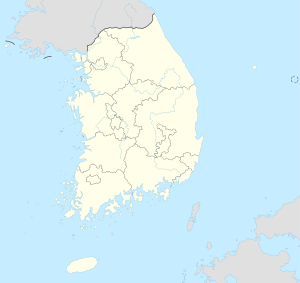Dogil Maeul
| Dogil Maeul | |||
|---|---|---|---|
| Korean alphabet : | 독일 마을 | ||
| Chinese characters : | 獨 逸 마을 | ||
| Revised Romanization : | Dogil Maeul | ||
| McCune-Reischauer : | Togil Maŭl | ||
| Basic data | |||
| Province : | Gyeongsangnam-do | ||
| Coordinates : | 34 ° 48 ' N , 128 ° 2' E | ||
| Surface: | 0.1 km² | ||
| Residents: | 70 | ||
| Population density : | 700 inhabitants per km² | ||
| map | |||
|
|||
Dogil Maeul ( Korean : 독일 마을 ; German : German village) is a small village on the island of Namhaedo ( 남해도 ) in the province of Gyeongsangnam-do ( 경상남도 ) in South Korea .
geography
The village is located 100 m above sea level on a hillside above a small valley on the east coast of Namhaedo Island. Administratively, the village belongs to the rural community Samdong-myeon ( 삼동면 ) of Namhae-gun County ( 남해군 ). The Mulgeonhang bay ( 물건항 ), which has been developed into a harbor, is 1 km east of the village and offers a view of and access to Koreastrasse . The village is connected by the 559 km long national road 3 ( 국도 제 3 호선 ), which connects Namhae-gun with Cheorwon-gun in the north of the country.
history
The origin of the place goes back to an initiative of the mayor of Namhae-gun, Du-Kwan Kim ( 김두관 ), in the year 2000.
When Kim visited Germany in 1997, in the district of North Friesland , he was confronted with requests from former Korean guest workers in Germany that they might want to return to their homeland when they retire. Since Namhae-gun has been constantly losing inhabitants since 1965 due to emigration to the industrial regions of Korea, Kim took up the wishes and developed the idea of building a German settlement in the district, on the one hand as a thank you to those who left Korea in the 1960s to live in To be able to work in Germany and to support their families with the money they sent home, but also to create an attraction for tourists at the same time. In 2000 the district acquired almost 100,000 m 2 of land, divided it into 64 building sites of around 500 m 2 in size, laid out the infrastructure and made it a condition that the houses and the village complex should look as “German” as possible.
It should be whitewashed two-story houses with red hip or gable roofs , with the roofs sloping between 30 and 35 degrees. Lawn gardens, low fencing, and exterior lighting around the house were other conditions. Around US $ 7.5 million had flowed into the project by 2005 and by the end of 2009 29 of the 40 houses planned in the first construction phase had already been built. In July 2012 the village had 39 German looking houses.
today
The settlement project was an attraction in Korea from the start and is still today. Especially on weekends, tourists from the northern parts of the country come to marvel at the village. Not all the residents of the village are happy about the large number of visitors, and quite a few do not think that the houses are also inhabited. Tourists go into the gardens without being asked and have no problem going into houses when the door is open. There are also typically German signs such as "No entry" or "Private property" on quite a few houses, albeit in two languages.
But one weekend a year, thousands of tourists flock to the village, namely when Oktoberfest is celebrated with lots of beer and sausages in October. In 2012, around 10,000 vehicles were expected to clog the narrow streets of the village over the three days of the festival.
Movie
A critical analysis of the wishes and desires of settlers of the village on the basis of some individual fates provides the film terminus of the aspirations of the director Cho Sung-hyung . The film was u. a. 2009 shown and presented at the Berlinale .
- Dogil Maeul (독일 마을)
Web links
- Internet presence of the German village (German)
- 독일 마을 . 독일 마을,Retrieved December 16, 2012(Korean).
- 제 1 회 보물섬 남해 독일 마을 맥주 축제, 열광 의 현장 을 가다 . Beer2day.com, October 20, 2010,accessed on December 16, 2012(Korean, blog entry with photos about the Oktoberfest in Dogil Maeul in 2010).
Individual evidence
- ^ Henning Sussebach: Our German village. Zeit-Online, October 13, 2005, accessed December 16, 2012 .
- ↑ Koo Min-Kyoung: When the new home travels to the old home “Dogil Maeul” - The “German Village” in South Korea . In: Stadt + Grün . 58th year. Patzer Verlag, October 2009, ISSN 0948-9770 , p. 62-67 .
- ↑ Norimitsu Onishi : In a Corner of South Korea, a Taste of German Living . The New York Times , August 9, 2005, accessed December 16, 2012 .
- ^ A b Manfred Ertel: German Village in South Korea - Homeless in East Germany. Spiegel-Online, July 8, 2012, accessed December 16, 2012 .
- ^ Matthias Kolb: Dogil Maeul. The German village . In: Bauwelt . 99th year, no. 36 . Bauverlag BV GmbH, Berlin September 26, 2008, 2. Urban, regional and state planning, p. 86-89 .
- ↑ Tanja Wolff: Longing for Mettwurst and garden gnomes. Süddeutsche, May 17, 2010, accessed December 16, 2012 .
- ↑ End of the line for longings. Berlinale, 2009, accessed on December 16, 2012 .
- ↑ Program 2009. Berlinale, accessed on December 16, 2012 .





